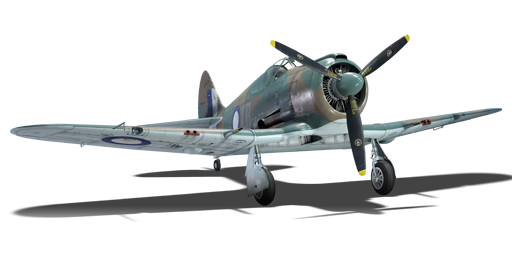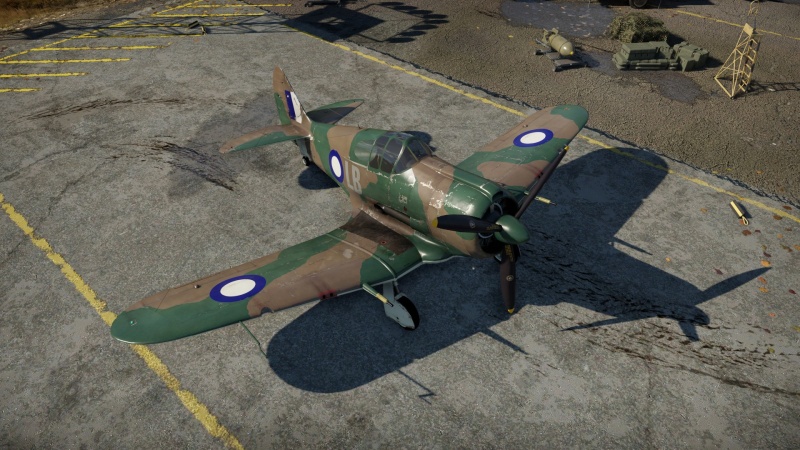Boomerang Mk I (Great Britain)
| This page is about the premium British fighter Boomerang Mk I (Great Britain). For the other version, see Boomerang Mk II (Great Britain). |
Contents
Description
The ▄Boomerang Mk I is a premium rank II British fighter with a battle rating of 3.3 (AB), 3.0 (RB), and 2.7 (SB). It has been in the game since the start of the Open Beta Test prior to Update 1.27. This variant of the Boomerang represents a version which was designed and manufactured in Australia.
General info
Flight performance
| Characteristics | Max Speed (km/h at 5,100 m) |
Max altitude (metres) |
Turn time (seconds) |
Rate of climb (metres/second) |
Take-off run (metres) | |||
|---|---|---|---|---|---|---|---|---|
| AB | RB | AB | RB | AB | RB | |||
| Stock | 472 | 456 | 10356 | 23.2 | 23.9 | 12.1 | 12.0 | 273 |
| Upgraded | 513 | 491 | 21.4 | 22.3 | 18.2 | 14.9 | ||
Details
| Features | ||||
|---|---|---|---|---|
| Combat flaps | Take-off flaps | Landing flaps | Air brakes | Arrestor gear |
| ✓ | ✓ | ✓ | X | X |
| Limits | ||||||
|---|---|---|---|---|---|---|
| Wings (km/h) | Gear (km/h) | Flaps (km/h) | Max Static G | |||
| Combat | Take-off | Landing | + | - | ||
| 660 | 320 | 487 | 445 | 225 | ~12 | ~9 |
| Optimal velocities (km/h) | |||
|---|---|---|---|
| Ailerons | Rudder | Elevators | Radiator |
| < 380 | < 370 | < 340 | > 323 |
| Compressor (RB/SB) | ||
|---|---|---|
| Setting 1 | ||
| Optimal altitude | 100% Engine power | WEP Engine power |
| 1,990 m | 1,100 hp | 1,188 hp |
Survivability and armour
- Armour plates
- 38 mm Bulletproof glass in front of the pilot.
- 12.7 mm Steel plate behind the pilot, with 3 mm steel plate flaps around it.
- 3 mm pentagonal steel box around the central fuel tank.
- Fuel tanks (self-sealing)
- 1 behind the pilot
- 1 in each wing's root (2 total)
Modifications and economy
Armaments
Offensive armament
The Boomerang Mk I (Great Britain) is armed with:
- 2 x 20 mm Hispano Mk.II cannons, wing-mounted (60 rpg = 120 total)
- 4 x 7.7 mm Browning machine guns, wing-mounted (1,000 rpg = 4,000 total)
Usage in battles
The Mk I Boomerang is not very fast for a fighter for its BR at roughly 460 km/h at sea level with WEP, and it loses power very quickly starting at an altitude of 4,000 meters due to a lack of a supercharged engine. From this, it would be thought that the Boomerang isn't much of a capable fighter, as many of its opponents are capable of reaching 500 km/h at any altitude. Despite this, the Boomerang makes up for this as it possesses great manoeuvrability due to its good roll rate and decent Power/Weight ratio. However, Boom and Zoom tactics are also possible with the Boomerang if an altitude advantage is present, as its decent rip speed, lack of rudder-stiffness at high speed and good rate of climb allows it to make passes on any enemies unfortunate enough to be underneath it.
Therefore, the Boomerang is best played in a turn-fighting role, almost (though not to the same extent) as a British A6M, as even though the statistics claim a rather average turn time, at low altitude it is a turning-monster, capable of competing with even some Japanese fighters.
The armament of the Boomerang is also quite acceptable for its rank, with 2 x 20 mm Hispano cannons and 4 x 7.7 mm Browning machine guns, though the ammo of the Hispanos is rather limited at 120. On the other hand, the Browning's possesses 4000 ammo, which allows the Boomerang to stay in the air for extensive periods of time. Furthermore, this significant amount of Browning ammo can be used with marked success in a ground pounding role in Air RB matches, mirroring its success in this role in the Pacific theatre.
Manual Engine Control
| MEC elements | ||||||
|---|---|---|---|---|---|---|
| Mixer | Pitch | Radiator | Supercharger | Turbocharger | ||
| Oil | Water | Type | ||||
| Controllable | Controllable Not auto controlled |
Controllable Not auto controlled |
Controllable Not auto controlled |
Separate | Controllable 2 gears |
Not controllable |
Pros and cons
Pros:
- Tight turn radius and good roll rate at low altitude
- A large amount of secondary machine gun ammunition (4,000 rounds)
- Large choice of ammo belts for both the cannons and machine guns
- Decent climb rate
Cons:
- Poor performance at higher altitudes, most notably above 4,000 meters
- Mediocre speed for a fighter aircraft (even for Rank II)
- Sub-par acceleration above 300 km/h
- Airframe causes aircraft to lose speed quickly in turns
- Cannons only have 60 rounds in each gun (120 total)
- Overheats very quickly when using WEP
History
The Boomerang Mk I is the first variant of the CAC Boomerang, a fighter aircraft developed by Australia's Commonwealth Aircraft Corporation (CAC). Designed to equip the RAAF after the start of the Second World War, the aircraft was the first indigenously-built Australian fighter aircraft. The Boomerang was very underpowered due to the limited engine choices, meaning that it was considerably slower than its contemporaries. The aircraft saw limited active service during the Second World War in both frontline and secondary duties.
In the late 1930s, with Nazi Germany and Japan both rapidly increasing the size of their militaries, the Australian Air Force (RAAF) looked to acquire a new fighter aircraft to replace their obsolete squadrons of F2A Buffalos. Following the start of the war, the RAAF was hard-pressed for fighters: the UK, Australia's primary source for aircraft, was barely supplying enough aircraft for itself, while the USA dedicated almost all of its manufacturing capacity to producing aircraft for the USAAF and USN. As a result, Australia was forced to produce a new fighter indigenously.
The RAAF turned to the CAC, which had been created in 1936 through the merger of several Australian aircraft companies. The CAC was already producing the Wirraway, a training and general-purpose aircraft; the CAC decided to create a new fighter on the basis of the Wirraway, as this could be done quickly and efficiently. The Wirraway's rear fuselage, tail and wings were mated to a new forward fuselage which housed a 1,200 hp Pratt & Whitney twin wasp engine. This prototype configuration first flew in May of 1942 and was later ordered into service as the Boomerang Mark I (contract number CA-12) - a total of 105 Boomerang Mk Is would be built during the war.
In service, the Boomerang proved to be very underpowered and much slower than most comparable allied fighters. In fact, the Boomerang never shot down a single enemy aircraft. The Boomerang proved to be more effective as a ground attack aircraft, replacing the lighter-armed Wirraway in this role: it was frequently used to drop ordnance or strafe enemy targets, or deploy smoke bombs to mark enemy targets. The Boomerang was retired soon after the war's end; five Boomerang Mk Is remain intact today, including two currently-airworthy aircraft.
| Archive of the in-game description | |
|---|---|
|
The CAC Boomerang was an Australian single-seat, single-engine fighter of mixed wood and aluminium construction. The Japanese attack on Pearl Harbour on December 7, 1941 and subsequent events in the Pacific theatre of operations showed how unready Australia was for war. The country had fewer than two hundred military aircraft, most of them obsolete. At that time, the Commonwealth Aircraft Corporation (CAC) only produced a trainer, the CAC Wirraway (a licensed version of the American NA-33). The License Agreement provided for modifications, so, in order to have fighter aircraft as soon as possible, the CAC decided to use the trainer as a basis for a new fighter. The CA-12 (later called the Boomerang Mk.I) was created, the first domestically produced fighter to ever roll off Australian assembly lines. The CA-12 borrowed the Wirraway's landing gear, tail, and wing design and was powered by a license built American Pratt and Whitney Twin Wasp engine, rated at 1,200 hp. The aircraft was armed with two 20 mm Hispano cannon and four 0.303 inch Browning machine guns and could carry four 9kg smoke bombs to mark targets, one 227kg bomb, or a 265 litre external fuel tank. The CA-12 had high durability, good armament, and excellent handling characteristics at low level, although this performance deteriorated at height and the fighter's top speed was not at all competitive. Mass production began in July 1942 and 105 Boomerang Mk I fighters were produced. | |
Media
- Skins
- Videos
See also
Links to the articles on the War Thunder Wiki that you think will be useful for the reader, for example:
- reference to the series of the aircraft;
- links to approximate analogues of other nations and research trees.
External links
| Commonwealth Aircraft Corporation (CAC) | |
|---|---|
| Attackers | ▄Wirraway |
| Fighters | ▄Boomerang Mk I · ▄Boomerang Mk II |
| Britain premium aircraft | |
|---|---|
| Fighters | Tuck's Gladiator Mk II · ▄Boomerang Mk I · ▄Boomerang Mk II · ▄D.520 |
| ▄Martlet Mk IV · ▄Corsair F Mk II · ▄Hellcat Mk II · ▄Thunderbolt Mk.1 · ▄Mustang Mk IA | |
| Hurricane Mk.I/L FAA M · Spitfire Mk.IIa Venture I · Spitfire F Mk IXc · Plagis' Spitfire LF Mk IXc · Spitfire F Mk XIVc · Prendergast's Spitfire FR Mk XIVe | |
| Typhoon Mk Ib · MB.5 | |
| Twin-engine fighters | Hornet Mk.I · Whirlwind P.9 |
| Jet fighters | Attacker FB.2 · Hunter FGA.9 · Lightning F.53 · Meteor F Mk.8 Reaper · Sea Vixen F.A.W. Mk.2 · F-4J(UK) Phantom II · ▄MiG-21 Bison |
| Strike aircraft | ▄Wirraway · Beaufighter Mk I (40-mm) · Wyvern S4 |
| Harrier GR.1 · Strikemaster Mk.88 | |
| Bombers | ▄Avenger Mk II · ▄Boston Mk I · ▄Catalina Mk IIIa · ▄DB-7 · ▄Havoc Mk I · ▄Hudson Mk V · Swordfish Mk II |





